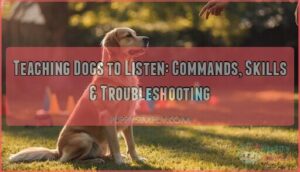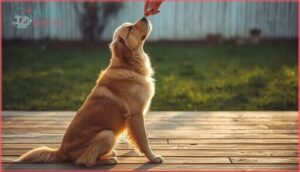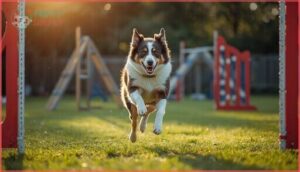This site is supported by our readers. We may earn a commission, at no cost to you, if you purchase through links.
Your dog hears you perfectly—he just doesn’t see the point in listening. That disconnect between hearing and responding frustrates more dog owners than any other training challenge, yet it’s entirely fixable once you understand how dogs process commands and decide whether to comply. The secret isn’t louder repetition or harsher corrections; it’s building a communication system where listening becomes your dog’s default choice, not a reluctant obligation.
Whether you’re wrestling with a stubborn puppy who treats “come” as a suggestion or refining an adult dog’s obedience, the techniques that transform unreliable responses into rock-solid reliability follow clear patterns. You’ll gain practical methods for teaching core commands, troubleshooting the roadblocks that stall progress, and advancing to complex skills that showcase what your dog can truly accomplish when training clicks.
Table Of Contents
- Key Takeaways
- How Dogs Learn and Respond to Training
- Socializing Dogs and Puppies
- Teaching Basic Obedience Commands
- Using Positive Reinforcement Effectively
- Training for Everyday Manners
- Advancing to Complex Skills and Tricks
- Troubleshooting Common Training Challenges
- Frequently Asked Questions (FAQs)
- What are the 7 most important dog commands?
- What is the hardest command to teach a dog?
- What are the five golden rules of dog training?
- What are the top 10 dog commands?
- What is the best age to start dog training?
- Can older dogs learn new commands and behaviors?
- How can I maintain consistency in training with multiple family members?
- Should I use punishment-based methods during training?
- How long does it take to train a dog with basic commands?
- How do I stop my dog from barking excessively?
- Conclusion
Key Takeaways
- Your dog’s refusal to obey stems from unclear communication and weak motivation, not stubbornness—building a reward system where listening becomes more valuable than ignoring you transforms compliance from obligation to default choice.
- Timing matters more than repetition; you’ve got a 0.5–1.5 second window to reward the right behavior before your dog loses the connection between action and consequence, making precision the difference between confusion and mastery.
- Socializing your puppy between 3–14 weeks prevents over 60% of behavioral problems later in life, since this critical window shapes how your dog responds to fear, novelty, and stress throughout adulthood.
- Training once or twice weekly in focused bursts beats daily marathons—dogs learn faster with spaced practice, and gradual exposure to distractions in controlled environments builds reliability that holds up in real-world chaos.
How Dogs Learn and Respond to Training
Before you can shape your dog’s behavior, you need to understand how they actually process what you’re teaching them. Dogs don’t learn the same way we do—they rely on different types of intelligence, pick up on subtle cues you mightn’t even realize you’re giving, and need the right setup to focus.
Let’s break down what’s happening in your dog’s mind during training and how you can work with their natural learning style.
Types of Canine Intelligence
Your dog’s mind works on three distinct levels. Instinctive intelligence draws on breed-specific talents—herding, retrieving, or guarding—that emerge without formal lessons. Adaptive intelligence lets your dog solve new problems independently, varying widely even within breeds. Working intelligence determines how quickly your companion learns and obeys your commands. Understanding these cognitive abilities transforms your approach:
- Recognize your dog’s instinctive strengths and channel them
- Challenge adaptive learning through novel problem-solving games
- Match training pace to your dog’s working intelligence level
- Celebrate breed variations instead of comparing unrealistic standards.
By considering the dog intelligence rankings, you can develop a more effective training strategy.
Role of Tone and Consistency
Once you grasp how your dog thinks, mastering your voice becomes your next advancement. Tone Awareness and Vocal Inflection drive obedience classes more than words alone—dogs decode your emotional state instantly. Consistent Cues paired with positive reinforcement build Clear Communication that transforms dog behavior and training.
Use these training methods to release genuine Emotional Intelligence in your partnership. Research confirms that friendly voices yield 90% recall success, while aversive methods spike cortisol and reduce engagement. Understanding voice tone benefits is vital for effective communication with your dog.
| Training Element | Impact on Your Dog |
|---|---|
| Cheerful, high-pitched tone | Boosts cooperation and tail-wagging enthusiasm |
| Harsh or inconsistent tone | Triggers stress, avoidance, and confusion |
| Single-cue delivery | Builds reliable response; repetition teaches delay |
| Matched tone and body language | Creates unambiguous signals your dog trusts |
| Predictable reinforcement patterns | Lowers cortisol, strengthens bond, accelerates learning |
Creating an Ideal Training Environment
Your voice sets the stage, but your space seals the deal. Minimizing Distractions—closing doors, silencing phones—cuts learning time nearly in half; dogs master tasks in 18 trials versus 31 with noise.
Optimizing Space with non-slip flooring prevents injury, while Temperature Control and proper Ventilation Quality keep focus sharp during home training. Pair warm Lighting Conditions around 3000K with positive reinforcement, and you’ll release obedience your dog can’t resist.
Essential Training Supplies
Once your space is ready, stock up on the right gear. You’ll need a sturdy leash and collar—the foundation of your training accessories—plus high-value treats that make your dog’s eyes light up. Clicker devices sharpen timing in reward systems, while a properly sized crate aids crate training. This training equipment transforms good intentions into real results.
Socializing Dogs and Puppies
Socialization isn’t just a nice bonus—it’s the foundation that shapes how your dog moves through the world. When you expose your puppy to new people, places, and situations early on, you’re building confidence and preventing fear-based problems down the road.
Let’s break down the key strategies that’ll help your dog become a well-adjusted, friendly companion.
Importance of Early Socialization
Think of puppy socialization as your dog’s emotional insurance policy—one that pays dividends for life. Between 3 and 14 weeks, your puppy’s brain is wired to embrace new experiences without fear. Miss this window, and you’re fighting an uphill battle against anxiety and aggression.
Early socialization techniques slash behavioral problems by over 60 percent, turning canine bonding into behavioral development that sticks.
Structured Puppy Classes
Structured puppy training classes usually run 6–8 weeks, with sessions lasting 45–60 minutes to match attention spans. You’ll want a class starting between 7–8 weeks of age, right after initial puppy vaccinations.
Look for trainers emphasizing positive reinforcement training and group sizes around 4–8 puppies—small enough for individual coaching.
Nearly half of attendees complete 10+ sessions, building strong foundations through dog obedience training and puppy socialization exercises that prevent future behavior issues.
Introducing New Environments
Dogs experience fear in novel situations at notable rates—11% show sensitivity to unfamiliar environments, while 23.5% become anxious on different surfaces. Start environmental adaptation between 3–14 weeks, when neural plasticity peaks.
Take your puppy to varied locations at least three times weekly for 10-minute sessions, pairing novelty exposure with positive experiences. This canine socialization technique builds confidence, aids stress reduction through social enrichment, and prevents adult fear responses effectively.
Reducing Aggressive Behaviors
Aggression surfaces when 55.6% of dogs react to fear responses or environmental factors they can’t control. You’ll reduce these triggers through behavioral modification: pair calm canine body language with rewards when your dog faces challenging stimuli.
Positive reinforcement changes emotional reactions in canine psychology, unlike punishment that masks warning signs. This dog behavior modification approach tackles root anxiety, preventing escalation before bites occur.
Teaching Basic Obedience Commands
Basic obedience commands give your dog the structure and clarity they need to navigate the world alongside you. These fundamental cues aren’t just about control—they’re about building a shared language that keeps your dog safe and confident in any situation.
Let’s break down the five essential commands that form the backbone of effective training.
Sit Command
You’ll master the sit command faster than you think—most dogs nail it within 5 to 10 training sessions of just 10 minutes each.
Focus on command timing, offering rewards the instant your dog’s rear hits the floor, and keep handler consistency sharp by using the same verbal cue every time.
These brief, focused training sessions build rock-solid dog obedience without overwhelming your pup.
Down Command
Teaching your dog ‘down’ demands more patience than sit, but you’ll discover a powerful tool for calm behavior and impulse control. Most dogs master basic commands like down in 4–6 weeks with daily 5–10 minute sessions using positive reinforcement—luring with treats from sit to lying flat.
Service dogs rely on down positioning for public access, proving its value beyond simple dog obedience.
Stay Command
Once your dog comfortably lies down, build “stay” by starting at arm’s length and rewarding every few seconds. Consistent dog training with positive reinforcement transforms stay from shaky to rock-solid in 4–6 weeks.
Distance Training essentials:
- Begin one step away, gradually reaching 20 feet
- Practice 5–10 minute sessions twice daily for Command Consistency
- Layer distractions only after basic stay becomes reliable
Reward Systems work—you’re creating impulse control that keeps your dog safe.
Come When Called
Now let’s tackle the command that keeps your dog out of traffic and safe in the wild—“come when called.” Recall training lays the groundwork for Off-Leash Training freedom.
Start indoors with zero distractions, use high-value treats, and call your dog’s name once followed by “come.”
Reward Systems create 90% success when you practice Emergency Recalls daily in low-stakes moments, building Distraction Control as you go.
Heel and Loose-Leash Walking
Once recall is solid, you can break free from that constant tug-of-war on walks. Leash Training transforms pulling into partnership—82.7% of dogs pull, but the fix is straightforward.
Heel Commands and Pulling Prevention rely on timing, not force.
- Start in a quiet area with your dog at your side
- Mark and reward the instant slack appears in the leash
- Stop moving when tension builds, resume when they check back
Using Positive Reinforcement Effectively
Positive reinforcement isn’t just about tossing treats—it’s about building a language your dog actually wants to speak. When you reward the right behaviors at the right moments, you’re creating a partnership built on trust instead of fear.
Let’s break down how to use rewards, timing, and training tools to make every session count.
Choosing The Right Rewards
Think of rewards as your training currency—high-value treats drive results. Food reward systems consistently outperform toys in progressive-ratio tasks, so choose high-protein, high-fat options that your dog craves.
Run simple palatability testing by offering two treats side-by-side; reserve top picks for tough commands. Rotating several preferred treats prevents boredom and keeps motivation strategies sharp.
Smart treat selection paired with positive reinforcement methods transforms ordinary sessions into pivotal moments.
Clicker Training Basics
Pick up a clicker and you’re unlocking operant conditioning’s most precise tool—marker training that captures the exact moment your dog nails a behavior. The clicker mechanics work as a conditioned reinforcer, bridging the gap between action and reward delivery through these dog training basics:
- Charge the clicker by pairing each click with a treat for 20 repetitions
- Click the instant your dog completes the desired behavior
- Follow every click with reward timing within 1–2 seconds
- Keep training sessions short at 3–5 minutes, repeated multiple times daily
This positive reinforcement method sharpens feedback clarity on basic commands while building your dog’s enthusiasm for learning.
Timing and Consistency of Rewards
Timing transforms dog training techniques from frustrating fumbles into pivotal moments—you’ve got a 0.5–1.5 second prime reward window to seal the connection between action and consequence. Deliver consistent feedback within that split-second and your training effectiveness skyrockets; wait three seconds and you’ve already lost the lesson, accidentally reinforcing whatever your dog’s doing now instead of what you wanted.
Reward your dog within 1.5 seconds or you’ll reinforce the wrong behavior entirely
| Timing Window | Training Effectiveness |
|---|---|
| Immediate (< 1 sec) | 60% task acquisition |
| Delayed (1 sec) | 25% task acquisition |
| Beyond 3 seconds | Markedly reduced learning |
Clicker training bridges delayed reinforcement brilliantly—that sharp click marks the exact moment, then your treat follows within 1–3 seconds.
Once your dog nails a behavior consistently, shift from rewarding every single response to intermittent positive reinforcement using unpredictable patterns. This variable schedule maintains rock-solid performance during training sessions without burning through your treat pouch, while continuous rewards speed up initial learning of new dog behavior management skills.
Avoiding Aversive Methods
Harsh corrections corrode trust and spike stress—aversive dog training methods trigger dramatically elevated cortisol, persistent fear, and pessimistic behavior patterns that undermine everything you’re building. Stick with humane training through positive reinforcement and reward-based techniques for stress reduction:
- Skip shock collars and physical corrections entirely
- Use clicker training for precise gentle techniques
- Redirect unwanted dog behavior management with treats
- Celebrate small wins consistently
Your dog learns faster, stays engaged longer, and actually wants to work with you when dog training techniques prioritize partnership over pressure.
Training for Everyday Manners
Teaching your dog basic obedience is one thing, but real-world manners are what make living together smooth and stress-free.
You want a dog who greets guests without launching at them, who doesn’t snatch food off the counter, and who sees their crate as a safe retreat instead of a cage.
Let’s walk through the everyday skills that turn good training into a well-mannered companion.
Proper Greeting Behavior
Jumping during greetings isn’t just bad manners—it’s a safety risk. Over 56% of dogs referred to behavioral clinics jump on people, and injuries spike when kids meet dogs face-to-face. Train “four-on-the-floor” by rewarding calm approaches and ignoring excitement. Teach greeting protocols to every visitor: no touch until paws stay down. Safe interactions depend on reading dog body language—watch for tension, paw lifts, or crouched postures that signal stress, not friendliness.
| Your Role in Greeting Etiquette | What It Means for Your Dog |
|---|---|
| Reward grounded, calm behavior | Builds impulse control and safety |
| Ignore jumping, withhold attention | Removes reinforcement for the unwanted act |
| Ask visitors to wait for calm approach | Creates consistency across all interactions |
| Read stress signals (yawning, tension) | Protects your dog from overwhelming situations |
Teaching “Leave It” and “Drop It”
Leave it” and “drop it” are your frontline safety protocols—teaching your dog impulse control around food, toys, or dangerous objects reduces resource guarding incidents and bite risks. Dogs trained with positive reinforcement master these cues faster, with training latency dropping to near-instant responses. Use clicker training and high-value rewards at home, gradually proofing behaviors across environments.
- Teach “leave it” by rewarding the moment your dog looks away from temptation
- Practice “drop it” through fun tug games, trading items for better rewards
- Track how quickly your dog responds—faster latency means stronger dog obedience and commands
- Proof both cues in multiple settings to guarantee reliable responses during walks or emergencies
Managing Jumping and Nipping
When your dog’s greeting feels more like a collision than a welcome, you’re facing the most common complaint among owners—over 90% of dogs jump on household members at some point.
Nipping prevention and jumping solutions center on calm greetings through consistent dog training: reward all four paws on the floor, redirect puppy behavior management with treats, and proof canine behavior across settings.
Aggression reduction follows when you replace force with patience, building biting causes awareness and training a dog at home with positive reinforcement that transforms overexcitement into dog behavior you can trust.
Crate Training Techniques
A properly sized crate—just big enough for your dog to stand, turn, and lie down—becomes a den, not a jail.
Start with three-minute sessions at four weeks, building to thirty minutes by eight weeks. Place it in a quiet space with soft bedding, reward entry with high-value treats, and never reward the exit.
That’s crate training: teaching safety through patience, not punishment.
Advancing to Complex Skills and Tricks
Once your dog has the basics down, it’s time to push beyond the familiar and build skills that truly impress. Expert training isn’t just about flashy tricks—it’s about deepening your dog’s focus, reliability, and confidence in any situation.
Here’s how to take your training to the next level.
Proofing Behaviors in New Settings
Contextual learning shapes how reliably your dog responds when you leave the living room and head to the park. Location proofing means re-teaching each cue in multiple environments—carpet to tile, backyard to busy street—because dogs don’t automatically generalize.
Environmental adaptation takes patience: start with quiet spots, then gradually layer in distraction training. Desensitization to new surfaces and sounds builds obedience training that holds up everywhere, from loose-leash walking downtown to recall training at the dog park.
Increasing Duration and Distance
Once your dog nails “stay” in a new setting, stretch how long they hold it and how far you can step away. Distance Training and Long Duration come next—building Expert Recall and off-leash reliability through structured sessions.
- Add five seconds at a time to stay, tracking progress weekly
- Step back incrementally during come when called drills, aiming for 30‑meter benchmarks
- Train one to two times per week in short bursts for steeper learning curves than daily marathons
Research shows dogs trained once or twice weekly in brief sessions outperform those drilled daily, and reward‑based Recall Techniques push first‑command compliance past 80 percent. That’s the edge you want before loose-leash walking through crowds or calling your pup across a field.
Introducing Distractions Gradually
Before adding movement and noise into your training sessions, you need to set your pup up to win. Start with a single low-level distraction—a stationary person ten feet away, for example—then gradually decrease distance or raise intensity once your dog responds correctly 80–90 percent of the time.
Research shows 85 dB acoustic distractors can tank performance and even trigger refusals, so Gradual Exposure is everything. Build Distraction Levels systematically using this framework:
| Distraction Type | Starting Point | Progress Marker |
|---|---|---|
| Noise Training | Quiet room | 85 dB tolerance |
| Visual Cues (motion) | Still object 30 ft | Moving person 5 ft |
Sensory Management keeps engagement high; nine of twelve dogs in one study quit under uncontrolled 85 dB noise, but structured protocols for loose-leash walking strategies and recall training let you proof sit-stay and come-when-called commands even around thrown toys. Layer one new variable—sound, movement, or smell—at a time to avoid shutdowns.
Transitioning to Advanced Tricks
Once your dog nails basic commands in distracting settings, you’re ready for expert trick training and complex skill building. Multi-step commands—like weave poles, retrieve-and-deliver, or position changes on cue—leverage cognitive development measured in assistance-dog programs, where early problem-solving scores predict adult task mastery.
Use clicker training to mark each micro-step, building agility techniques and intricate dog tricks one layer at a time.
Troubleshooting Common Training Challenges
Even the best training plans hit snags. Your dog might lose focus after a few minutes, seem anxious around new people, or just refuse to budge on a command you’ve practiced dozens of times.
Here’s how to tackle the most common roadblocks and keep your training momentum going strong.
Short Attention Spans
If you’ve noticed your dog’s gaze wandering mid-session, you’re not alone—research shows roughly 20% of dogs struggle with inattention. Attention limits vary by age: puppies manage about 2–3 minutes, while adolescent dogs can handle 10–15 minutes.
Keep training sessions brief, use multiple 3–4 minute focus techniques daily, and manage impulsivity with reward-based distraction control to boost come when called reliability and dog obedience techniques.
Overcoming Fear or Stress
Fear and stress can sabotage even the sharpest dog’s ability to focus. Research shows up to 72% of dogs display at least one anxiety-driven behavior.
Implement desensitization techniques by pairing fear triggers with rewards—this behavioral therapy achieved 100% success in one clinical series. Start with low-intensity exposures, gradually building confidence.
Anxiety treatment may include fluoxetine or clomipramine for severe cases, supporting your dog’s stress management and long-term behavioral science progress.
Dealing With Slow Progress
Slow progress doesn’t mean failure—it’s often a signal to adjust your approach. Dogs trained once weekly required fewer sessions overall than those trained daily, proving that training frequency matters less than quality.
Evaluate handler consistency and session length; structured positive reinforcement with data tracking cuts training time by up to 25%. Break complex behaviors into smaller steps, increase reinforcement rates, and watch for plateau strategies that restore upward momentum in dog training.
Maintaining Motivation and Engagement
Training starts to feel like a chore when your dog checks out—but engagement thrives when you match your method to what actually lights them up. Refresh your training techniques with these dog training tips:
- Reward Systems: Align treats or praise with your dog’s stable preferences; some dogs respond stronger to social reinforcement than food, sustaining motivation through positive reinforcement and clicker training.
- Training Schedules: Train once or twice weekly instead of daily—spacing improves learning efficiency and keeps sessions fresh.
- Play Breaks: Integrate play after training; dogs allowed post-session play outperformed resting controls even a year later, proving play breaks boost memory and engagement through an individualized approach rooted in dog psychology and stress management.
Frequently Asked Questions (FAQs)
What are the 7 most important dog commands?
The seven core commands that form the backbone of dog training are sit, stay, down, come, heel, leave it, and a release word. These safety commands establish control, prevent hazards, and build the foundation for all future obedience.
What is the hardest command to teach a dog?
Reliable recall tops the list because it demands your dog ignore powerful distractions—other animals, smells, play—and return from increasing distances.
Off-leash reliability takes extensive expert obedience work, patience, and distance training.
What are the five golden rules of dog training?
Five core principles anchor effective dog training: plan sessions carefully, reward consistently with positive reinforcement, maintain emotional control during obedience classes, start early to shape canine intelligence and behavior, and commit to lifelong learning.
What are the top 10 dog commands?
Most trainers agree: sit, stay, come, down, and heel form the core five, rounded out by leave it, drop it, off, wait, and watch me—creating a complete foundation for everyday control and safety.
What is the best age to start dog training?
You can start puppy basic training around 8 weeks, right when they come home. This critical socialization period—roughly 3 to 14 weeks—is your prime learning window for shaping confident, well-behaved dogs.
Can older dogs learn new commands and behaviors?
Yes, absolutely—your senior dog training is viable thanks to neuroplasticity, the aging brain’s capacity to forge new connections. While cognitive decline may slow learning capacity in older dogs, evidence shows many seniors successfully master new commands with patience and proper dog behavior reinforcement.
How can I maintain consistency in training with multiple family members?
Assign each person clear handler roles and use unified cues across your household.
Hold brief family meetings to coordinate training methods, agree on consistent rewards, and align dog obedience and discipline expectations before sessions begin.
Should I use punishment-based methods during training?
No—punishment-based methods damage dog welfare, increase fear and aggression, and don’t outperform positive reinforcement.
Reward systems build trust, achieve reliable obedience faster, and strengthen your bond without causing stress or behavioral problems.
How long does it take to train a dog with basic commands?
Training basic commands isn’t a sprint—it’s more of a “paws” for progress. Most dogs grasp sit, stay, and come within four to six weeks of consistent practice, though real-world reliability takes months of follow-through.
How do I stop my dog from barking excessively?
Excessive barking often signals anxiety, territorial instincts, or boredom. Identify barking triggers first—whether strangers, noise, or separation distress—then apply calming techniques like desensitization training, environmental management, and positive reinforcement to redirect your dog toward quiet behavior.
Conclusion
Training isn’t about dominating your dog—it’s about speaking their language fluently. The path from ‘maybe later’ to immediate compliance runs through clear communication, smart reinforcement, and consistent practice.
Teaching dogs to listen transforms from exhausting battle to collaborative conversation when you build value into every interaction. Your dog won’t ignore commands that predict rewards, adventure, and connection.
Start with one reliable behavior, layer complexity gradually, and watch reluctance dissolve into enthusiastic partnership.
- https://www.proficientmarketinsights.com/market-reports/dog-training-services-market-1911
- https://www.businessresearchinsights.com/market-reports/dog-training-services-market-117475
- https://www.accurizemarketresearch.com/report/dog-training-services-market
- https://www.biorxiv.org/content/10.1101/823427v1.full-text
- https://www.reddit.com/r/reactivedogs/comments/kepzx0/training_methods_based_on_punishment_compromise/

















